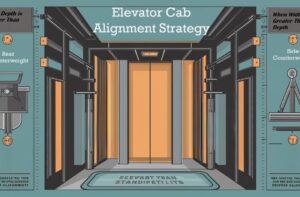Living in a high-rise offers stunning views and convenience, but the constant rumble of elevators can disrupt your peace. This guide explores the causes of elevator noise in skyscrapers, its impact on residents, and effective solutions to create a quieter living environment.
Fast-moving elevators in high-rise buildings can cause issues with vibration, noise, and atmospheric pressure. The noise and vibration that elevators create can have a detrimental effect on people’s health and well-being, as well as the community’s level of comfort.As a result, high-rise buildings need to find ways to reduce elevator vibration and noise.
The source of noise?
You must identify the source of the sound if you want to stop the elevator from making noise.
Elevatos Tale

In today’s urban environments, high-rise buildings are becoming increasingly common. These architectural marvels provide essential solutions to space constraints by building upward. However, one often overlooked challenge that comes with these towering structures is elevator noise. As high-speed elevators zip up and down, they create various noises and vibrations that can significantly impact the comfort of building occupants. Understanding the sources and implications of this noise, and implementing effective solutions, is crucial for ensuring a peaceful living and working environment in high-rise buildings.
a) The Dynamics of High-Speed Elevators
High-speed elevators are designed to travel rapidly between floors, often reaching speeds that exceed 20 miles per hour. This swift movement is essential for efficient vertical transportation in tall buildings, but it also generates noise and vibrations. These disturbances can disrupt the comfort of residents and occupants, necessitating comprehensive noise management strategies.
The elevator noise comes from
- Air Pressure Changes: One primary source of noise in high-speed elevators is air pressure changes. As these elevators move quickly through their shafts, they cause air pressure fluctuations that create a whooshing sound. This noise is especially pronounced in taller buildings where elevators cover greater distances at higher speeds.
- Machinery Noise: The machinery involved in elevator operation is another significant contributor to noise. Motors, geared motor copper wear, and control panels housed in the machine room generate a considerable amount of noise during their operation. This constant mechanical activity creates a symphony of sounds that can permeate the building structure.
- Vibrations and Structural Transmission: Elevator movements cause vibrations that can travel through the building’s structure. These vibrations can pass through walls, floors, and ceilings, transmitting noise to nearby apartments and offices. Structural transmission of noise is a major concern in high-rise buildings, as vibrations from elevator operations can affect areas far from the elevator shaft.
b) Noise Pathways: Airborne and Structure-Borne
To effectively reduce elevator noise, it is essential to understand the two primary pathways through which noise travels: airborne and structure-borne.
- Airborne Noise: This noise is transmitted through the air, carrying sound waves from the elevator shaft to adjacent spaces. This type of noise can easily penetrate walls and doors if they are not properly soundproofed. Airborne noise includes the whooshing sounds caused by air pressure changes and the mechanical sounds from the machine room.
- Structure-borne noise is transmitted through the building’s physical structure. Vibrations caused by elevator movements travel through walls, floors, and ceilings, reaching living and working spaces. This type of noise is often more challenging to address, as it requires interventions that dampen vibrations at their source and along their transmission path.
C) Key Sources of Elevator Noise
Several specific components and aspects of elevator systems contribute to the overall noise levels experienced in tall buildings. Understanding these sources is the first step toward effective noise mitigation.
- Machine Room: The machine room houses the motors, gears, and control panels essential for elevator operation. The constant activity within this room generates a substantial amount of noise, which can be transmitted both as airborne and structure-borne noise. High-rise buildings often place machine rooms at the top or bottom of the elevator shaft, where noise can easily spread to nearby areas.
- Elevator doors, particularly non-axial doors, can create significant noise when opening and closing. The friction and mechanical movements involved in door operation contribute to the overall noise levels. This noise is often most noticeable in the immediate vicinity of the elevator doors.
- Elevator Rails: The interaction between elevator rails, bearings, rollers, and cables generates noise as the elevator moves along its shaft. This interaction is a source of both airborne and structure-borne noise. Regular maintenance of these components is crucial to minimizing noise levels.
- Air Pressure Changes: As mentioned earlier, air pressure changes caused by the rapid movement of elevators result in distinctive whooshing sounds. These pressure fluctuations are an inherent part of high-speed elevator operation, making it essential to implement measures that mitigate their impact.
d) How to Control Elevator Noise
Mitigating elevator noise in high-rise buildings requires a multifaceted approach that addresses both airborne and structure-borne noise. Advanced soundproofing techniques and smart design choices are essential for creating a quieter environment.
- Advanced Soundproofing: High-quality soundproofing materials can significantly reduce noise transmission. Applying these materials to elevator doors, machine rooms, and shafts helps to block airborne noise and dampen vibrations. Soundproofing materials such as mass-loaded vinyl, acoustic panels, and soundproof insulation are effective solutions for minimizing noise levels.
- Vibration dampers are devices designed to absorb and mitigate vibrations. These dampers can be installed in various parts of the elevator system, including the machine room, elevator shaft, and structural elements. By reducing the transmission of vibrations, dampers help to minimize structure-borne noise.
- Noise-reducing panels provide an additional layer of defense against elevator noise. These panels, often made from sound-absorbing materials, can be installed in the elevator shaft and machine room. They help to dampen noise within the elevator system, preventing it from spreading to other areas.
- Smart Design: Implementing smart design choices during the construction of high-rise buildings can significantly impact noise levels. Minimizing gaps and openings in elevator shafts and using soundproof doors are effective strategies. Additionally, placing machine rooms in locations where noise is less likely to disrupt occupants can make a big difference.
- Thick Walls: Constructing thick walls with soundproof materials is another effective solution. Walls exceeding 200mm in thickness and made with soundproof concrete can significantly block airborne noise. This approach is particularly useful for areas adjacent to elevator shafts and machine rooms.
e) Case Studies: Success Stories in Noise Reduction
Several high-rise buildings have successfully implemented noise reduction strategies, resulting in quieter environments for their occupants. These case studies highlight the effectiveness of various noise mitigation techniques.
Building A: Advanced Soundproofing and Vibration Dampers
Building A, a 50-story residential tower, experienced significant noise issues from its high-speed elevators. The building management team decided to invest in advanced soundproofing materials and vibration dampers. By applying these materials to the elevator doors, machine room, and shaft, they were able to reduce noise levels by over 50%. Residents reported a marked improvement in their living conditions, with less disturbance from elevator noise.
Building B: Noise-Reducing Panels and Smart Design
Building B incorporated noise-reducing panels and smart design choices during its construction. The elevator shafts were lined with sound-absorbing panels, and the machine room was strategically placed away from residential areas. Additionally, soundproof doors were installed to further block airborne noise. These measures resulted in a significant reduction in elevator noise, enhancing the overall comfort of the building’s occupants.
Building C: Thick Walls and Structural Modifications
Building C, a commercial skyscraper, faced challenges with structure-borne noise due to its high-speed elevators. The building’s management team opted for thick walls made of soundproof concrete and structural modifications to dampen vibrations. By reinforcing the walls adjacent to the elevator shaft and adding vibration-absorbing materials, they achieved a substantial decrease in noise levels. Office workers reported a quieter and more productive environment.
f) Building Regulations and Standards
Building regulations and standards play a crucial role in ensuring that noise levels in high-rise buildings are kept within acceptable limits. These regulations are designed to protect the comfort and well-being of occupants by setting guidelines for noise control.
- Noise Level Limits: Many countries and municipalities have established noise level limits for residential and commercial buildings. These limits specify the maximum allowable noise levels in different areas of a building. Compliance with these regulations is essential for maintaining a comfortable living and working environment.
- Building codes often include specific requirements for noise control in high-rise buildings. These codes may mandate the use of soundproofing materials, vibration dampers, and other noise mitigation techniques. Adhering to these codes ensures that buildings are constructed with noise control in mind from the outset.
- Acoustic testing is a critical part of ensuring compliance with noise regulations. Testing involves measuring noise levels in various parts of a building to verify that they meet the required standards. Regular acoustic testing helps identify potential issues and allows for timely interventions.
g) Future Trends in Elevator Noise Reduction
As technology continues to advance, new solutions for reducing elevator noise are emerging. These innovations hold the promise of even quieter high-rise buildings in the future.
- Smart elevators: Smart elevators equipped with advanced sensors and control systems can optimize their operation to minimize noise. These elevators can adjust their speed and movement patterns to reduce air pressure changes and vibrations. Additionally, smart elevators can communicate with building management systems to provide real-time data on noise levels, allowing for proactive noise management.
- Innovative Materials: The development of innovative materials for soundproofing and vibration damping is another promising trend. Researchers are exploring materials with superior sound-absorbing properties that can be integrated into elevator systems. These materials have the potential to offer more effective noise reduction solutions than traditional options.
- Integrated Building Design: A holistic approach to integrated building design can further enhance noise control. By considering noise mitigation as a key aspect of building design from the early stages, architects and engineers can create structures that inherently minimize noise levels. This approach involves close collaboration between various stakeholders, including elevator manufacturers, building designers, and acoustic experts.
Conclusion
Elevator noise is a common challenge in high-rise buildings, but it is one that can be effectively managed with the right strategies. By understanding the sources and pathways of elevator noise, and implementing advanced soundproofing, vibration damping, and smart design techniques, building managers can create quieter and more comfortable environments for occupants. Adhering to building regulations and staying abreast of emerging trends in noise reduction technology will further enhance the quality of life in high-rise buildings.




